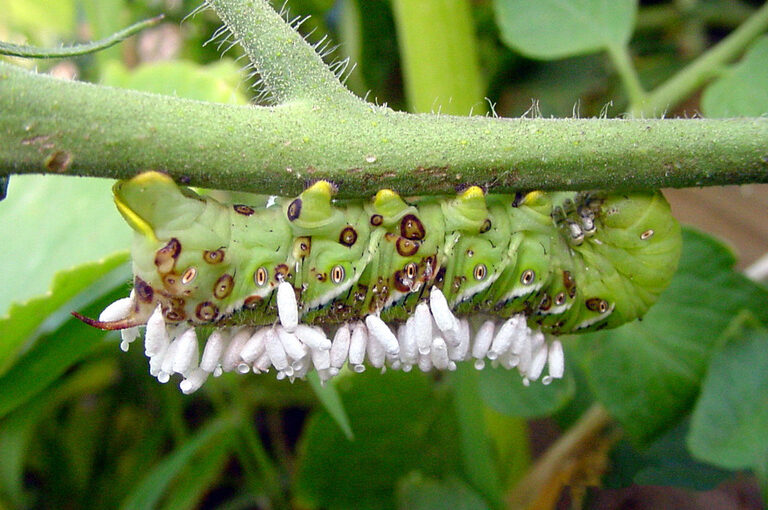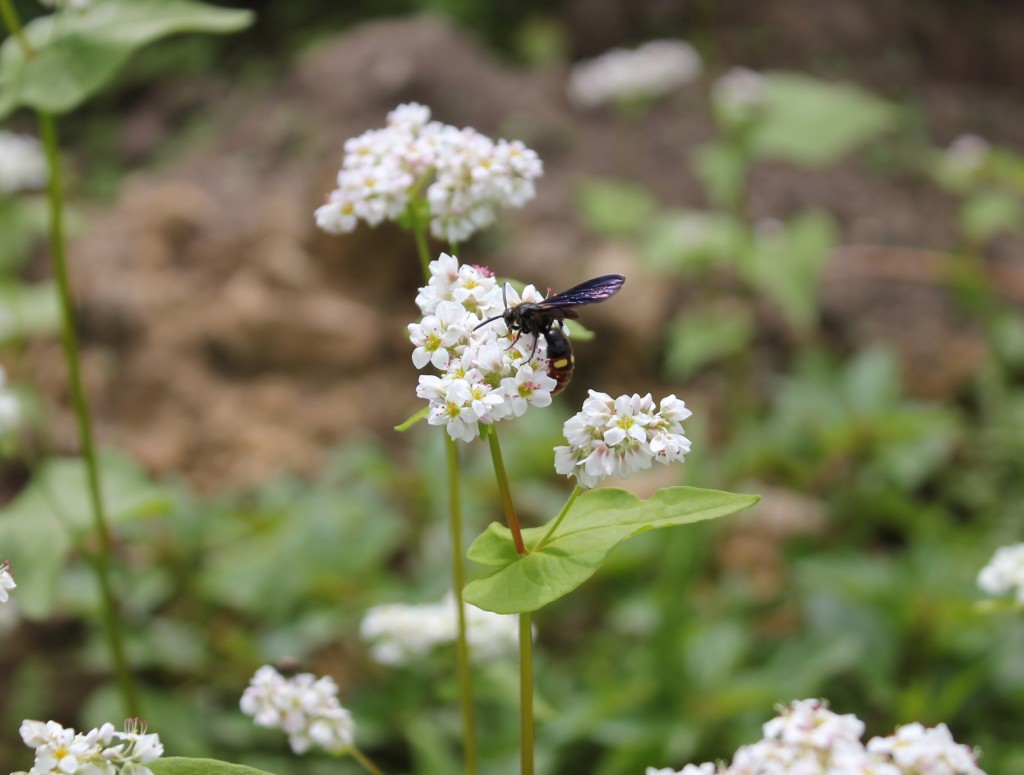Continuing with the theme of Underrated Beneficial Arthropods that I brought up in my December post about Underrated Pollinators– I will be focusing on the next category of what I consider the trio of beneficial arthropods (which includes pollinators, natural enemies, and nutrient cyclers).
Natural Enemies
Natural enemies are comprised of predatory and parasitic arthropods, in which one or more life stages of the arthropod feed on other organisms, such as garden pests, thereby killing them. Many gardeners are familiar with this group which includes some of our most ‘famous’ predatory arthropods such as mantids, lady beetles, lacewings, etc. This category, however, contains a plethora of beneficials that you may not always think about because most of what they do often occurs behind the scenes.
This is also a very broad category so this post will not be a comprehensive collection of all the natural enemies out there (because there are literally countless) but will have a variety of some of the most abundant, important, and unique. Like the last post it will be grouped by order or major category of Arthropod, where I will go into examples of the rockstars within that category. I will also include several resources at the end which I used to compile this information and encourage those of you who want to dig deeper into the world of natural enemies to take a look.
Flies
Flies (order: Diptera) are an incredibly diverse group of insects which provide a wide variety of different ecosystem services. They undergo complete metamorphosis (which basically means that they have 4 growth stages starting as an egg, and a major transition from their larval form of maggots that turn into pupae, and then into the adults that we recognize as flies). As such, flies also inhabit countless different ecosystems (including terrestrial and aquatic) and can be found on every continent including Antarctica. We learned about pollinating flies in the Underrated Pollinators blog post but, like many of the arthropods that we are going to cover, flies span all 3 of the major categories of beneficial arthropods. We will discuss them a bit more in-depth in the nutrient cycler category, but for this post I wanted to highlight some examples of the cool predatory and parasitic flies that we can find in our yards and gardens.
Tachinid flies [Tachinidae] are dark-colored medium-sized flies that are recognized by the dark bristles covering the body of the adults (which look similar to house flies). This family contains over 8000 described species and can be found on nearly every continent. The cool thing about this group is that every single species of Tachinids has a parasitic larval stage and many are continually utilized as natural enemies of many common pest species. As such, these flies have also been intentionally imported into various locations for biocontrol purposes. The targets of tachinids include a variety of different arthropods including caterpillars, sawflies, grubs, adult beetles, and many more! To learn more about this awesome group of parasitic flies, check out this excellent article on Tachinids written by Susan Mahr of University of Wisconsin-Madison.
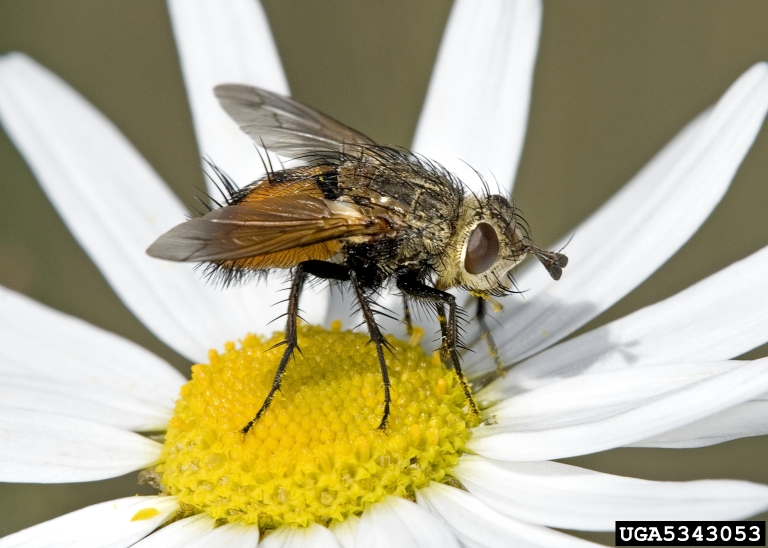
Hover flies [Syrphidae] also known as flower flies or ‘Syrphids’ are another awesome group (you might recognize them from their shout-out as pollinators in their bee-resembling adult stage). Larval syrphids can be terrestrial or aquatic. You may recognize the term “rat-tailed maggots” which refers to the aquatic larval syrphids that have a breathing tube resembling a ‘tail’ at the end of their body. They are used in biocontrol of a variety of soft-bodied arthropods including aphids, mealybugs, thrips, mites, and more. To learn more about hover flies, check out this excellent resource about their use as a biocontrol agent from Cornell University.

True Bugs
True bugs (Hemiptera and Homoptera) contain a variety of easily recognizable garden inhabitants that can be characterized by their piercing/sucking mouthparts. Although there are many plant feeders and common pests in this category (including aphids, cicadas, mealybugs, leafhoppers, scale insects, stink bugs, etc.) there are also some excellent natural enemies that don’t always get the spotlight. Often referred to as ‘Predatory Bugs’, this fierce category of insects includes assassin bugs [Reduviidae], big-eyed bugs [Geocoridae], minute pirate bugs [Anthocoridae], damsel bugs [Nabidae], and predatory stink bugs [Pentatomidae]. They vary in shape and size, but feed in the same way: by piercing their prey with their mouthparts and sucking out the fluids. Many are, therefore, excellent biocontrol agents in our yard and garden landscapes. Some are even commercially available for use in greenhouses and hoop houses/high tunnels to suppress populations of common soft bodied insect and mite pests. To learn more about them, check out this great article on Predatory Bugs from Colorado State University.
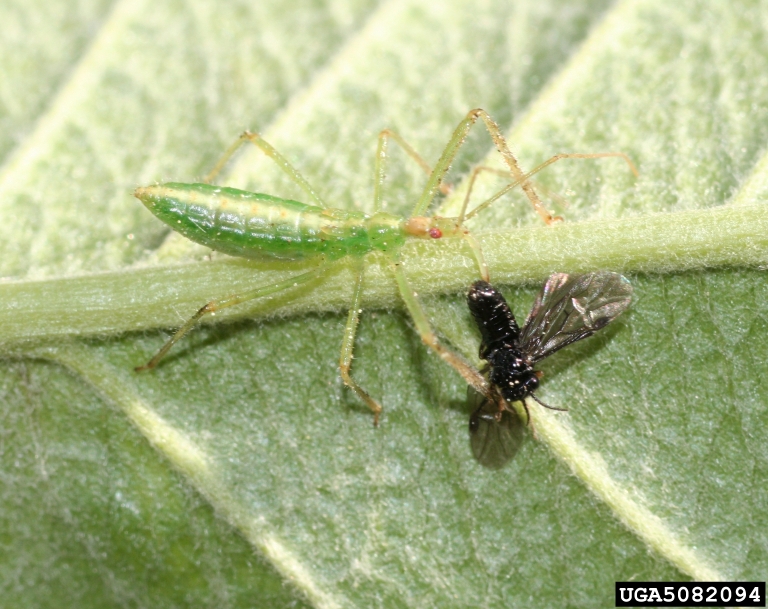
Wasps
Wasps (order: Hymenoptera) often strike fear in many people who are unaware of the sheer diversity and complexity of this group of insects. You learned about the pollinating wasps in my last Blog post, but there are also several groups of predatory and parasitoid wasps that are commonly found in our landscapes. Predatory wasps include many different species including the commonly known social wasp species (such as yellow jackets, hornets, and paper wasps) but also include countless other predatory species. One group of these common predators includes the striking family of thread-waisted wasps [Sphecidae]. This family includes spider-hunting wasps, cricket-hunter wasps, and katydid wasps. Another common family includes the cicada-killers [Crabronidae] which are a large and intimidating-looking wasp species that are actually harmless to humans. Both of these groups of solitary wasps work similarly by paralyzing their prey (often characterized by their common names) and then bringing their live bodies back to their underground nests for their larvae to feed on.

Parasitoid wasps are an incredibly large group of wasps which include many species varying greatly in size and shape. If you’ve seen the movie ‘Alien’ you have an idea of what the life cycle of these wasps is like. The mother lays her eggs in a living host (which spans countless species of insects), and her larvae feed on the host from within, until they emerge as adults. This includes groups such as braconid wasps [Braconidae], ichneumon wasps [Ichneumonidae], and families such as Aphelinidae, Scelionidae, Eulophidae, and Trichogrammatidae. Each species of parasitoid wasp needs another species of host insect in which to complete its life cycle, and entomologists estimate that there may be hundreds of thousands of species of these incredible organisms! Many parasitoid wasp species are important biocontrol agents for some very famous insect pests (including the Emerald Ash Borer, which those of us in North America are very familiar with). You can even purchase some commercially available species of these parasitoids to manage certain pests in your gardens and greenhouses. There are even hyperparasitoids which are parasitoid wasps that specifically use other parasitic wasps as hosts. To learn more about the incredible world of wasps, check out this great article by Marissa Schuh from University of Minnesota.
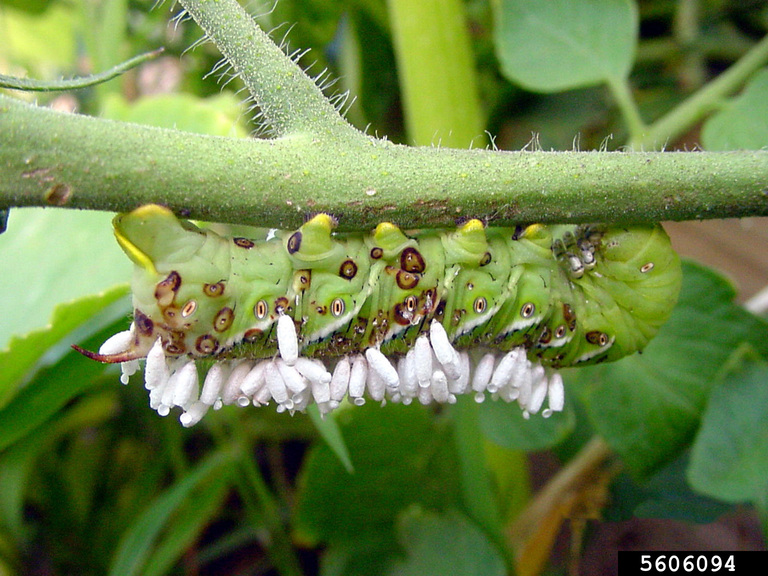
Beetles
Beetles (order: Coleoptera) are one of the most diverse groups of insects and include groups that fall into each of the three categories of beneficial arthropods. Although some are pests in their larval and/or adult stages (example: Japanese beetles) and feed on a variety of different plant structures including leaves, stems/trunks, fruit, flowers, seeds, and roots. We are also familiar with some of these predatory beetles (with many shining a spotlight on the easily recognizable and lovable lady beetles). That being said, there are countless other groups of predatory and parasitic beetles that can have a significant beneficial impact on our landscapes.
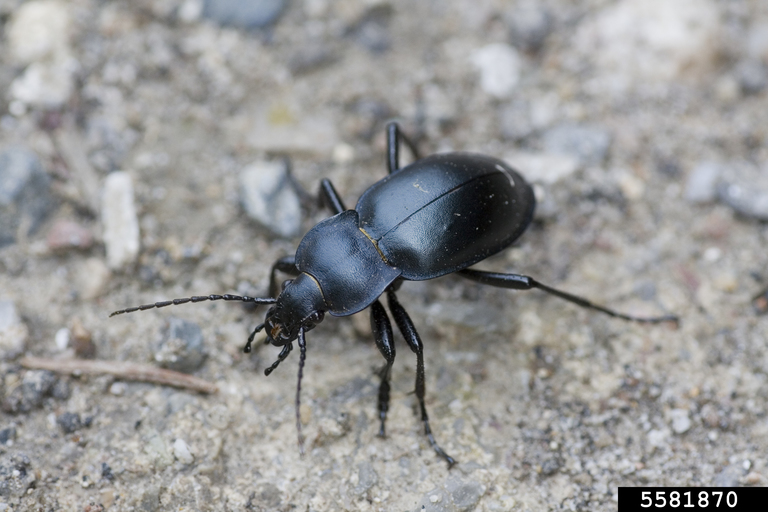
One example of a large group of these are the predatory ground beetles [Carabidae]. This dark and iridescent family of beetles can vary in size and shape. They have distinct and powerful chewing mouthparts (mandibles) which enable them to be excellent generalist predators and scavengers. The more than 40,000 species (spanning every continent except Antarctica) are common garden-inhabitants and perform invaluable services of biocontrol in agricultural, horticultural, and home garden settings.
In addition to feeding on many insect and mollusc pests, certain host-specific groups of plant-feeding beetles are also used in the biological control of weed species (including many noxious weeds) and reared by insectaries for distribution.
Neuroptera
Neuroptera (derived from the Greek words meaning “nerve” and “wing”) is an entire order consisting only of predatory insects! The most famous of this group are the lacewings [Chrysopidae] (which many gardeners recognize as an awesome predator of many soft-bodied garden pests). This order also includes other incredible species such as antlions or “doodle-bugs” [Myrmeleontidae], dobsonflies [Corydalidae], mantidflies or mantid lacewings [Mantispidae], snakeflies [Raphidiidae], and more.

Mites
Mites (subclass: Acari) are another often misunderstood group of arthropods. These are arachnids (characterized by 4 pairs of legs and two body segments). Mites feed on countless living and decaying organisms including plants, animals, fungi, yeasts, algae, mosses, and even bacteria. They range in size, though most are tiny and many are even microscopic soil-dwelling organisms. The sheer diversity of mite species (due to their very broad range of ecological roles) indicates that there may be over a million species that have yet to be described.
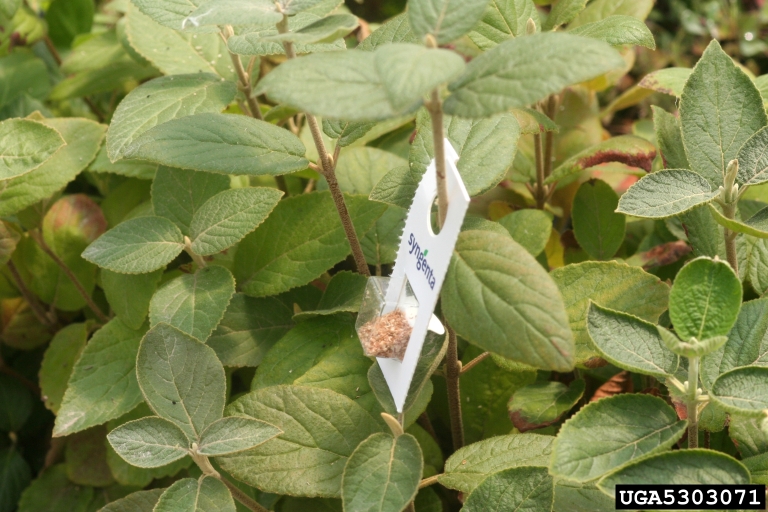
Many gardeners recognize some common mite pests (such as the two-spotted spider mite), but there are countless predatory mite species as well. Predatory mites [Phytoseiidae] are slightly larger than spider mites, and excellent predators of spider mites and eriophyid mites which are common plant-gall causing mites. There are several species used in biocontrol of soft-bodied insect and mite pests as well as commercially available ones that you can purchase.
Spiders
I am sure that no one reading this post would be surprised to find these amazing arachnids on this list. Although some species are dangerous to humans, most species of spiders will leave you alone, and are incredible predators of lots of indoor and outdoor insect pests. Many humans dislike these 8-legged organisms, though most are still understanding of the important role that they play. Spiders can be strikingly beautiful, colorful, and variable in size and shape. Although some build webs to capture prey, others are active hunters or trappers that capture other organisms on which to feed. Some are even kept as pests (I had 4 tarantulas of my own at one point, and I thoroughly enjoyed observing them daily, and handling the more mild-mannered ones). There is so much that can be said about the incredible role of spiders in our homes, gardens, and natural ecosystems that it would be difficult to condense into a short summary (and may therefore be a separate Blog post in the future since this one is getting pretty lengthy).
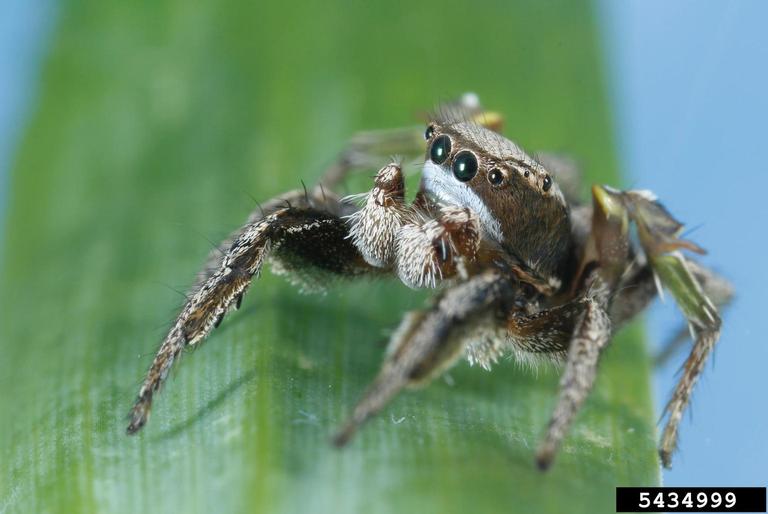
Centipedes
Centipedes span 4 different orders including soil centipedes [Geophiulomorpha], garden/rock centipedes [Lithobiomorpha], giant centipedes [Scolopendromorpha], and house centipedes [Scutigeromorpha] all of which are carnivorous. This group of arthropods is characterized by many body segments, venomous fangs, and 1 pair of legs per segment. Although many people are creeped out by these ferocious many-legged beasts, they stay out of the way and eat many common pests in home and garden landscapes.
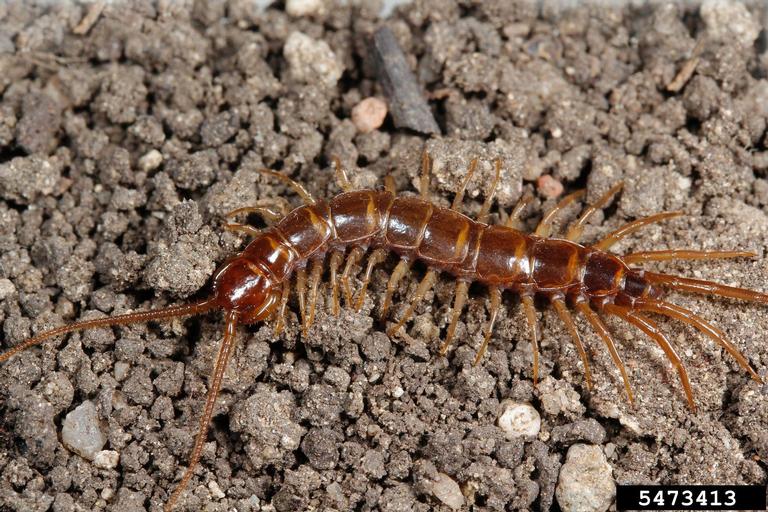
I hope that you enjoyed reading about some of your gardening companions, and if nothing else: I hope that it broadened your perspective of all the different critters that share your landscape with you. Stay tuned for my next post in June, which will cover the third and final category of beneficial arthropods: the nutrient cyclers.
Resources
Natural
Enemies of Pests. (Colorado State University).
https://agsci.colostate.edu/agbio/ipm/natural-enemies-of-pests/
Tachinid
Flies. (University of Wisconsin-Madison).
https://hort.extension.wisc.edu/articles/tachinid-flies/
Syrphid
Flies. (University of Minnesota Extension).
https://extension.umn.edu/beneficial-insects/syrphid-flies
Hover Flies.
(Cornell University).
https://cals.cornell.edu/new-york-state-integrated-pest-management/outreach-education/fact-sheets/hover-fly-biocontrol-fact-sheet
Wasps are a gardener’s friend. (University of Minnesota Extension). https://extension.umn.edu/yard-and-garden-news/wasps-are-gardeners-friend
Cicada
Killer Wasps. (University of Kentucky).
https://entomology.ca.uky.edu/ef004
Parasitoid
Wasps. (University of Minnesota).
https://extension.umn.edu/beneficial-insects/parasitoid-wasps
Hyperparasitoid
Wasps. (North Carolina State University).
https://entomology.ces.ncsu.edu/biological-control-information-center/beneficial-parasitoids/hyperparasitoids/
Predatory
Ground Beetles. (Colorado State University).
https://agsci.colostate.edu/agbio/ipm-pests/ground-beetles/
Biological
Control of Weeds. (Washington State University).
http://invasives.wsu.edu/biological/index.htm
